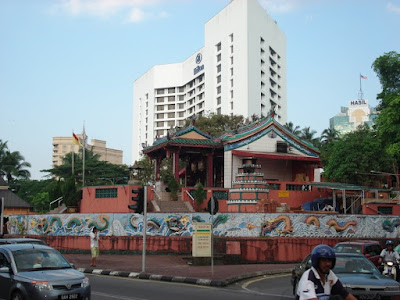Tua Pek Kong, Kuching - the Feng Shui Legend
The Kuching Tua Pek Kong Temple was once seated on the best Feng Shui location in Kuching; as according to the Feng Shui principle, a hill at the back, a small and smooth flowing river in front (the lost Sg Kuching), and the best front view of the highest peak in the area, Gunung Serapi.
The temple was built more than two centuries ago, long before James Brooke, the first White Rajah of Sarawak, arrived in Kuching.
Like most Chinese temples, the temple prosperity affected and associated highly to the businesses, emotion and activities of the local Chinese community in the early days where majority were followers of Taoist related faith. It was also one of the few buildings that survived the 1884 the Great Fire of Kuching, where most Chinese believed was due to good Feng Shui.
It was said that after the 1857 Chinese Insurrection in Bau, a gold mine township nearby, the Brooke Administration was worried about the Tua Pek Kong dominance and its influence to the local Kuching Chinese community. The growing strength of the local Chinese might affect the political power of the Brooke Administration.
A plan was thus initiated to weaken the Feng Shui of the Tua Pek Kong Temple. In 1928, in the name of development, Sg Kuching in front of the temple was filled up for road construction, in order to destroy the flowing ‘chi’ in front.
The hill (Bukit Pasu or Bukit Mata) at the back of the temple was cut through with an additional road on the left, with the exit just besides the temple, in order to weaken the dragon ‘chi’. The additional road through the hill was viewed unnecessary by the local Chinese at that time.
The current Chinese History Museum squared building, also believed to be part of the plan, was erected in 1912 just a few meters in front of the temple, to block ‘The Red Phoenix’; the building was used initially to mediate local Chinese affairs and other arbitration.
Good or bad Feng Shui, legend or facts, the Tua Pek Kong Temple continues to stand there as a growing tourist attraction; the legend had long been forgotten, and the temple has gone through the Brooke Administration, the Japanese occupation for three years, the British Crown Colony, Sarawak self-government a while, and now part of Malaysia.
The future and prosperity of Tua Pek Kong Temple will seem to depend more on its harmony with the local tourism, and cultural awareness of the local Chinese community.








Comments
Post a Comment